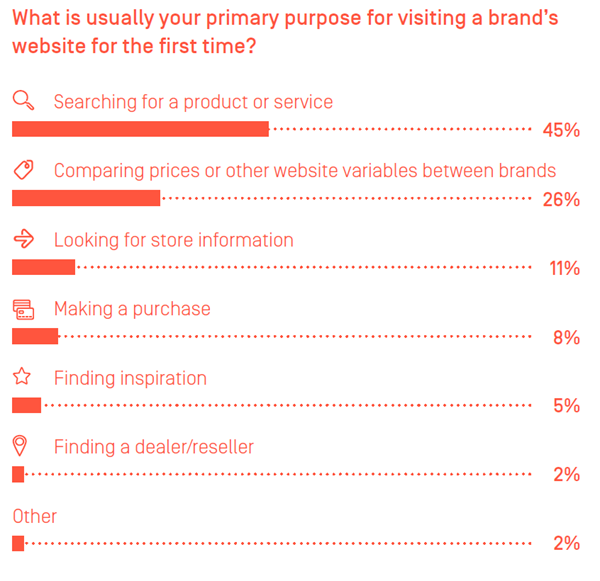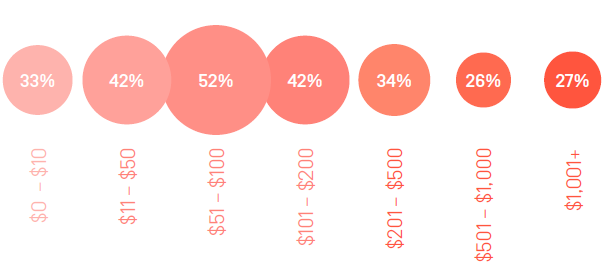Episerver: 92% of Consumers Don't Intend to Make a Purchase
I hate to break it to you, but the vast majority of the online shoppers who visit your online store are not there to purchase anything. However, if you sell them an experience rather than just a product, your prospects will become current customers soon enough. In fact, the recent Episerver study, “Reimagining Commerce,” finds that ninety-two percent of over 1,110 U.S. consumers surveyed visit a brand’s website for the first time to do research and find information, underscoring the need for relevant, accurate content rather than make a purchase.

Source: Episerver's Reimagining Commerce Report
The shopping experiences are emotional, guided, and a primary driving factor for visitors to add a product to their cart. You should consider every aspect of your online store as building a long-term sales pattern, and that is always more valuable than viral results that won’t last. Good news is, you do not need to reinvent the wheel as there is so much data on what works and what consumers really care about. In its recent report, Episerver made it easier for online retailers by providing the key findings based on its survey along with actionable recommendations on each pain point. One of the key findings specifically piqued my attention: “Over a quarter of shoppers chose customized content as one of their top three contributors to a great digital user experience while one in 10 ranked it number one.”
Sell an Experience, Not a Product
Today, the majority of online retailers already realize that a solid content strategy will result in increased traffic, organic search rankings, brand awareness, conversion rates, and sales, however, many struggle to make it work in real-life. Therefore, they end up throwing a bunch of content against a wall and waiting to see what sticks. This results in not only wasted time but also a loss of revenue as you are becoming obsolete to your prospects.
To put this into perspective, the same study suggests that 43 percent of respondents expect brands to know about their purchase histories, followed by personal interests with 25 percent, demographics with 20 percent, and billing information with 17 percent. Besides this research, there is a tremendous amount of statistics out there on how personalized content has an impact on purchasing decisions and how companies make delivering personalization their top priority. This obvious demand for personalized experiences is driving web content management vendors to adopt stronger, more tightly integrated personalization capabilities. Today, many vendors provide very viable personalization solutions either through acquisitions and strong partnership or from building the capabilities in house. Episerver, for instance, announced three more additions to its Omnichannel Personalization Suite, based on its most recent acquisitions of Peerius, a provider of intelligent omnichannel personalization in the cloud, and Optivo, a provider of omnichannel campaign management and customer intelligence solutions. During our recent conversation with James Norwood, Executive Vice President of Strategy and CMO at Episerver, he emphasized the importance of being armed with a rich content management system (CMS) around a commerce engine: “Although Episerver is very much thought of as just being a content management software provider, 50 percent of what we do is digital commerce. Episerver is the only company to provide a unified platform to help agile, mid-market organizations smartly manage digital content, commerce and marketing using the cloud. We do that so they can deliver these really differentiated – and even individualized – experiences for their customers wherever they engage, and they can do it fast.”
I couldn’t agree more with James Norwood on the need for solid commerce technology along with a CMS that has or can smoothly integrate personalization capabilities based on user behavior such as clicks, page views, and purchases, as well as demographic data like location, language, job role, and industry, if you want to have a leg up on the competition against popular commerce sites like Amazon. Learn more about the features your content management system must have, here.
The study also revealed which price range for products and/or services consumers expected to see personalized content when shopping on a brand’s website or mobile app. Frankly, I was surprised by the finding as it cited that more than half of consumers desire relevant content when shopping for products or services within the $51-$100 price range:

Source: Episerver's Reimagining Commerce Report
Nevertheless, personalization is a sophisticated and complex area so it is paramount to make sure you have a solid grasp on what your goals are and what to expect. Don’t forget that it is a team effort so see if you have a strong UX expert and Information Architect on your team who will lead the project to integrate personalization into the core of your platform. Instead of attempting a “Big Bang”, start small by applying it to where it makes the most sense, then assess and experiment what worked and what didn’t to finally, expand to other areas of your site.
How to Lose Shoppers Online
The study also unveiled the three main reasons why shoppers have been dissuaded from completing a purchase:
-
Incorrect and/or incomplete content: 98 percent of shoppers do not complete a purchase due to incomplete or incorrect content when visiting a brand’s website with the intent of purchasing. To me, this is a worrisome statistic. Every single content displayed on the website should be well considered. Your product description is your content, too. It should provide rich, informative but digestible information where you not only list the features of your products but also mention the benefits so buyers can relate to their own issues. More importantly, it is where you will pitch your value proposition because many shoppers do not transact due to a more competitive price, according to the study. However, there is a way out: more competitive customer experience. In fact, Gartner estimates that customer experience will overtake price and product as the key brand differentiator by 2020 as 64% of people Gartner surveyed said customer experience is more important than price in their choice of a brand.
-
Creating inconsistent expectations: Inconsistent expectations have major financial implications for brands. Nearly half (48 percent) of shoppers have returned a product because it wasn’t what they expected. Another study also revealed that shoppers returned over $250 billion worth of items to U.S. retailers in 2015. To tackle this issue, online retailers should implement the ability to zoom in on product images and embed product videos, how-to videos, and guideline infographics into their websites so consumers can build more accurate expectations.
-
Failing to personalize the shopping experience: The report cites that 35 percent of shoppers feel brands do a poor or very poor job of personalizing the online shopping experience. As I discussed earlier, why personalization matters and the existence of technology, marketers that deliver personalized web experiences are getting double digit returns in marketing performance and response. So if your website still offers irrelevant ads, irrelevant product recommendations, and non-personalized web content, you may either take an action or wait to become irrelevant in your visitors’ eyes. If you are interested in some quick wins, Episerver’s report delves into how to craft website content based on individual shopper insights.
At the end of the day, it all boils down to customer journey, and the checkout sits in neither the beginning nor the end of it. If I was writing this article a couple of years ago, I might say that technology hasn’t caught up with today’s tech-savvy customers’ high expectations powered by Google and Amazon. However, I don't believe it is the case anymore. Yes, maybe Facebook still sometimes makes predictive assumptions based on my one-off shopping experience such as a Christmas gift purchase but overall, all the major content management systems and e-commerce platforms provide a breadth of capabilities that businesses can take advantage to deliver a seamless digital experience for their prospects and existing customers. I think that there is an exchange of profitable benefit to the organizations for a little bit of time and effort being given away to each department.
If you are interested in learning more about e-commerce, I highly recommend you reading the other popular CMS-Connected articles entitled 7 Emerging eCommerce Technology Innovations, eCommerce Trends and Statistics, and How to Drive Sales with Your eCommerce Content Strategy.

Venus Tamturk
Venus is the Media Reporter for CMS-Connected, with one of her tasks to write thorough articles by creating the most up-to-date and engaging content using B2B digital marketing. She enjoys increasing brand equity and conversion through the strategic use of social media channels and integrated media marketing plans.